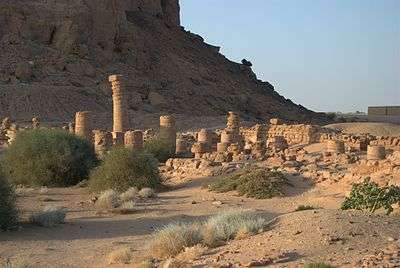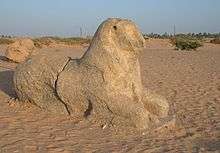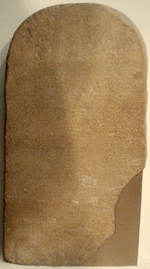Temple of Amun, Jebel Barkal
 Southwest view of Amun Temple at Jebel Barkal | |
| Location | Karima, Northern State, Sudan |
|---|---|
| Region | Nubia |
| Coordinates | 18°32′7″N 31°49′50″E / 18.53528°N 31.83056°ECoordinates: 18°32′7″N 31°49′50″E / 18.53528°N 31.83056°E |
| Type | Sanctuary |
| Part of | Jebel Barkal |
| History | |
| Builder | Probably Thutmose III |
| Founded | 13th century BC |
| Official name | Gebel Barkal and the Sites of the Napatan Region |
| Type | Cultural |
| Criteria | i, ii, iii, iv, vi |
| Designated | 2003 (27th session) |
| Reference no. | 1073 |
| Region | Arab States |
The Temple of Amun is an archaeological site at Jebel Barkal in Northern State, Sudan. It is situated about 400 kilometres (250 mi) north of Khartoum near Karima. The temple stands near a large bend of the Nile River, in the region that was called Nubia in ancient times. The Temple of Amun, one of the larger temples at Jebel Barkal, is considered sacred to the local population. Not only was the Amun temple a main centre of what at one time was considered to be an almost universal religion, but, along with the other archaeological sites at Jebel Barkal, it was representative of the revival of Egyptian religious values.[1] Up to the middle of the 19th century, the temple was subjected to vandalism, destruction, and indiscriminate plundering, before it came under state protection.[2]
History
When the Egyptians conquered the Kingdom of Kush in the early Eighteenth Dynasty, they identified Jebel Barkal as their state god Amun's place of birth and his chief southern residence. Amun cults were established in many Nubian locales, but beneath the cliff of Jebel Barkal the Egyptians constructed a major religious center, named Napata, which became the southernmost town in Egypt's African empire.[3] The actual settlement or townsite was probably built some distance away from the religious center, perhaps at Sanam Abu Dom.[4]

Construction of the temple occurred in the 13th century BC.[5] The temple's foundation probably occurred during the reign of Thutmose III, while the temple was shaped during his reign and that of Ramses II.[6] Especially at the time of the Napatan empire, the temple was of great importance for the Kushite kingdom. The Nubian king Piye and subsequent Nubian pharaohs expanded Barkal's Amun temple complex, creating a southern rival to the northern Amun temple at Thebes.[7] Although early Meroe rulers had their own capital, government officials took a coronation journey to the Amun Temple of Jebel Barkal. Here, the king went into the Holy of Holies, where he was confirmed as king by a divine oracle. In the years 25/24 BC, the Romans invaded Nubia during a campaign against the Kushites led by Gaius Petronius. He destroyed the temple and took Jebel Barkal from one of the Kandakes; however, the Romans were unable to make permanent gains and withdrew after razing Napata to the ground.[8] The last large-scale construction works were by the Kushite king Natakamani, who restored some of the Roman destruction, enlarged the temple complex,[9] and renovated the first pylon and other parts of the temple.

Architecture and fittings
The original temple was relatively small, consisting of one pylon and a courtyard with ten columns. During the Nineteenth Dynasty reign of Pharaoh Ramesses II, the structure included the Second and Third Pylons, a hypostyle court, a hall with annexes, a chapel, and a pronaos and naos complex.[6] Additions included a second temple behind a pylon, another courtyard, probably without pillars, and several chapels.
A notable temple renovation and enlargement, attributed to Piye, occurred in three stages. First, the old temple was strengthened by a wall and another small portico. For the second step, a large hall with 50 columns, was built. Only the pillars, foundation walls and entrances were made of sandstone, the remaining walls were of unbaked bricks. Lastly, Piye built a large farm, which was also decorated with columns. The court and the portico each had its own pylon. The whole temple complex became over 150 metres (490 ft) long. North of the First Pylon, a cache of statues was excavated, which included the headless statue of Tantamani (known also by his Amon name, "Tenutamon"), Taharqa's successor.
Many rulers built additional stele, decorated walls or put up statues in the temple. As the religious center was important to both Egyptians and Nubians, Thutmose III stele contains the inscription, "Home of Amun and the Throne of the Two Lands";[10] found at the Amun temple, it is now at the Museum of Fine Arts, Boston. There are stelea attributed to Horemheb and Seti I. Taharqa built ten colossal figures. Tantamani erected a small shrine in the portico. In the first courtyard, there are pillars attributed to Piye and Harsiotef.
References
- ↑ UNESCO/CLT/WHC. "Gebel Barkal and the Sites of the Napatan Region". UNESCO. Retrieved 11 August 2012.
- ↑ Reisner, George Andrew (1970). The Barkal temples. Museum of Fine Arts. p. 3. Retrieved 11 August 2012.
- ↑ Kendall, Timothy. "Jebel Barkal History and Archaeology". National Corporation of Antiquities and Museums (NCAM), Sudan. Retrieved 11 August 2012.
- ↑ Morkot, Robert (2003). Historical Dictionary of Ancient Egyptian Warfare. Scarecrow Press. pp. 149–. ISBN 978-0-8108-4862-7. Retrieved 11 August 2012.
- ↑ White, Jamila. "Wonders: City of Jebel Barkal - BLACK KINGDOMS OF THE NILE EPISODE". PBS. Retrieved 11 August 2012.
- 1 2 Török, László (2002). The Image of the Ordered World in Ancient Nubian Art: The Construction of the Kushite Mind, 800 Bc-300 Ad. BRILL. pp. 309–. ISBN 978-90-04-12306-9. Retrieved 11 August 2012.
- ↑ Smith, Stuart Tyson. "The Cities". University of California, Santa Barbara. Retrieved 11 August 2012.
- ↑ Lockyer, Sir Norman (1911). Nature (Public domain ed.). Macmillan Journals Limited. pp. 517–. Retrieved 11 August 2012.
- ↑ Harkless, Necia Desiree (30 August 2006). Nubian Pharaohs and Meroitic Kings: The Kingdom of Kush. AuthorHouse. pp. 109, 149–. ISBN 978-1-4259-4496-4. Retrieved 11 August 2012.
- ↑ Remler, Pat (2010). Egyptian Mythology, A to Z. Infobase Publishing. pp. 151–. ISBN 978-1-4381-3180-1. Retrieved 11 August 2012.
- Bibliography
- Dunham, Dows: The Barkal Temples. Excavated by George Andrew Reisner. Museum of Fine Arts, Boston, Massachusetts, 1970.
- Kendall, Timothy: "Excavations at Gebel Barkal, 1996. Report of the Museum of Fine Arts, Boston, Sudan Mission". In: Kush. 17, 1997, ISSN 0075-7349, pp. 320–354.
External links
| Wikimedia Commons has media related to Temple of Amun in Jebel Barkal. |